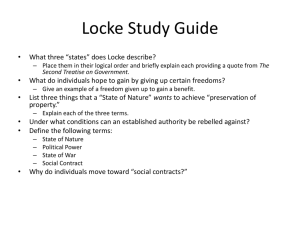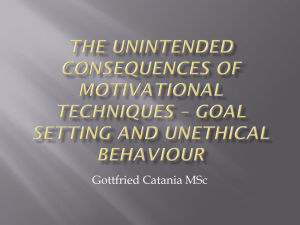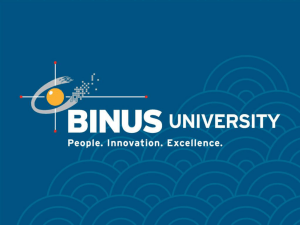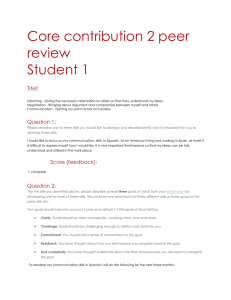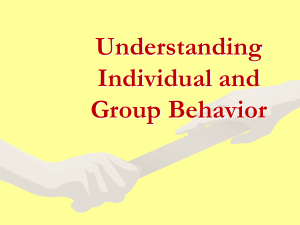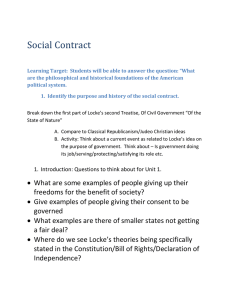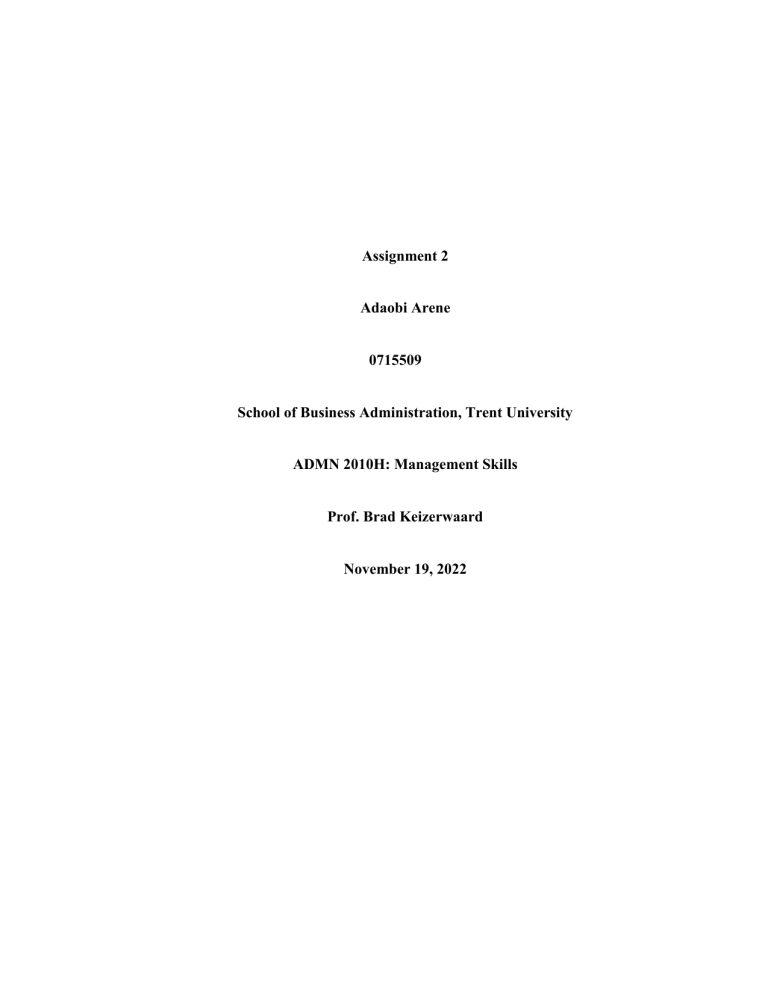
Assignment 2 Adaobi Arene 0715509 School of Business Administration, Trent University ADMN 2010H: Management Skills Prof. Brad Keizerwaard November 19, 2022 1. What are four key points to remember for setting goals? Briefly describe. According to Locke and Latham (1990), Four key points to remember for setting goals are clarity, challenge, commitment and feedback. (Locke & Latham 1990). Clarity: You know what you are attempting to accomplish when your objectives are crystal clear. Additionally, you know which actions to reward and can accurately measure results. Therefore, the acronym SMART is so helpful. Challenge: Although it is a frequent assumption that objectives that are too simple or too tough do not inspire individuals, Locke & Latham discovered a positive direct link between the difficulty of the objective, effort, and performance. It is crucial not to pick a goal that is too difficult to attain, though. Commitment: Locke, Shaw, Saari and Latham (1981) suggest that the team must be aware of and support the objectives for it to be successful. This does not imply that you must discuss and get team members' approval for every objective. Team members are more likely to stick to the goal if they think it is realistic, aligns with the company's objectives, and the individual assigning it is trustworthy. (Locke, Shaw, Saari and Latham 1981). Feedback: You have the chance to change the objective difficulty and explain people's expectations through feedback. Limit the number of objectives you set for your team, and make sure they are related to critical business projects. You should choose the appropriate goals and pay attention to feedback to gauge how well you and your team are going. (Bonnie, 2021). 2. List and describe the three types of professional networks. The three types of professional networks are work networks, social networks, and career networks. Work networks: People that are active in your present employment make up your work network. Anyone you depend on to perform your job duties, including your supervisor, coworkers, employees, clients, and vendors, is a part of your work network. Social networks: Refers to the connections you make or keep outside the boundaries of your present employment. Your social network consists of former coworkers, professors, friends, and individuals you meet at networking events. Career networks: Your network of career contacts combines the two above. A close friend or co-worker who leaves their position but continues working in your industry and stays in touch with you later in both professional and personal settings is an example of someone in your career network. 3. Explain and contrast the four attitudes toward authority. Counterdependence: This is a strong dislike of receiving help or support from others. People who are counter-dependent unconsciously overcompensate for emotions of vulnerability. They make a concerted effort to preserve their independence, refusing assistance and emotional support and keeping an emotional distance from others. Overdependence: Overly dependent persons never have enough assistance or support. These individuals are dependent, uneasy, and subservient. Because they are afraid of losing the interest and moral support of those in positions of power, they have little faith in their talents and views and never question or argue with them. Independence: A person who has a record of independence has cultivated a positive feeling of self-worth and self-reliance. Independent people take ownership of their activities and embrace personal responsibility. Interdependence: This has to do with the understanding that collaboration is key to success and that having deep, personal relationships has a positive impact on both one's life and career. Because they are confident in their abilities and believe that authorities are trustworthy and dependable unless shown differently, independent people may transition into interdependence with ease. 4. Explain the five steps of the ILETS model for conducting difficult conversations and why they are each important. The five steps of the ILETS model are: Introduce: Introduce the topic. Instead of being speculative or judgemental, this should be specific and accurate. Listen: The other person should be heard. To better grasp what is being stated, ask questions and use paraphrasing. Empathize: This entails being able to grasp another person's viewpoint and place oneself in their shoes. Talk: Now it is your turn to talk and tell your perspective. You should objectively convey facts. Solve: Resolve the issue. After hearing the accounts of both sides, it is possible to move toward a resolution. 5. What are the two approaches to managerial coaching? Briefly describe each. Which is the best approach? Provide a rationale for your response. Directive coaching: Here, the coach establishes objectives for the person or group, makes recommendations about how to get there, discovers resources, keeps tabs on progress, and provides constructive criticism. The coach is the specialist and instructs the person or group. Non-directive coaching: This approach to coaching invites the worker to consider their issue and produce a unique solution. Even in complex situations, this teaching method typically works better but takes more time. I believe non-directive coaching is the best approach because non-directive coaching assists individuals in gaining the techniques and confidence they need to take control of their learning. It is proactive and forward-thinking. Coaching that is non-directive focuses on potential and capacity which I believe are important in the development of the individual. 6. List and describe the five steps of the life cycle of a team The five steps of the life cycle of a team are forming, storming, norming, performing, and adjourning. Forming: The team members must establish a working relationship and determine their goals and a strategy for achieving them. As a result, social contacts make up most team interactions throughout the team-building stage. Storming: The team members must now look for a means to work together and advance as they are now aware of each other's unique backgrounds and skill sets. Teams frequently consist of multiple separate groups at this level, each with its unofficial leader. These organizations typically develop around various working processes or broad objectives. To move forward, the entire team must reach an agreement on both, though. The team's output either declines or stays flat because of the opposing points of view during the forming period. To increase productivity and prevent ongoing challenges in the future, the team must resolve all underlying concerns. Norming: The Norming stage is the first indication that the team is going in the right direction, but the unity at this stage is still very fragile. If new issues arise and the team fails to solve them, they can go back to the Storming stage and thus reduce their productivity once more. Performing: At this point, everyone is cooperating to achieve a single objective and delivering consistent, predictable outcomes. If new concerns develop, they are handled constructively rather than endangering the team's performance. Adjourning: As targets are met and work begins to wind down, the last stage will start. Others may keep working while losing several team members, which would alter the dynamics of the entire group. In any case, the team no longer exists at this stage of the team development lifecycle. (Teamhood, 2022). References Bonnie, E. (2021, July 26). Science-Backed Goal Setting Techniques You Need to Know (and 4 to Avoid Like the Plague). Wrike. https://www.wrike.com/blog/science-backed-goalsetting-techniques-need-know-4-avoid-like-plague/ Daft R. L. & Marcic D. (2014). Building management skills: an action-first approach. SouthWestern Cengage Learning. Locke, E. A., Shaw, K. N., Saari, L. M., & Latham, G. P. (1981). Goal setting and task performance: 1969–1980. Psychological Bulletin, 90(1), 125-152. Locke, E. and Latham, G. (1990). A theory of goal setting and task performance. Englewood Cliffs: Pearson College Div. Team Development Cycle – from Forming to Performing (2019-2022). Teamhood. Retrieved November 20, 2022, from https://teamhood.com/team-performance-resources/teamdevelopmentcycle/#:~:text=The%20team%20development%20cycle%20is,Norming%2C %20Performing%2C%20and%20Adjourning.
